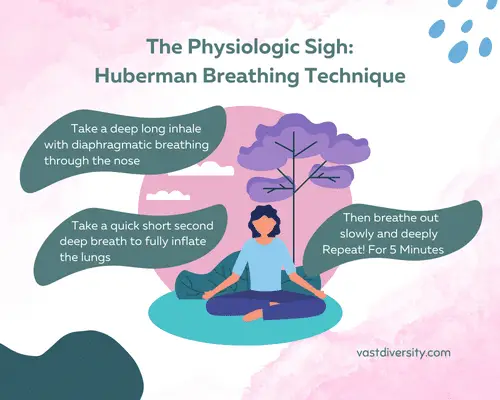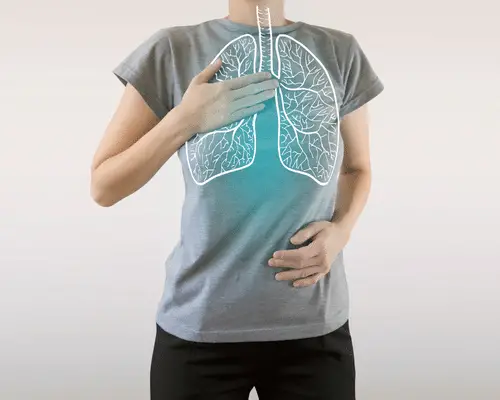Dr. Huberman says that the physiological sigh is a technique that will calm you down the most quickly and is the most rapid way to reduce stress in real time.
What is a Physiological Sigh?
A physiological sigh is a breathing technique that can have very rapid and deep effects on your physical and mental well being.
Specifically, a physiological sigh is two very deep inhales through the nose followed by a long exhale.
The first inhale is a deep, long inhale, followed immediately by a second inhale that is very quick and short.
The reason for the second inhale is to fully expand the lung, specifically the alveoli of the lungs. The alveoli are millions of little sacs at the edges of the lungs, and inflating them increases the surface area of the lungs.
Increasing the surface area of the lungs allows more oxygen to pass from the lungs to the blood stream, and more carbon dioxide to pass from the blood stream into the lungs so you can breathe it out.
Then you have a long exhale through the mouth until your lungs are empty.
A physiological sigh reduces levels of stress and lowers your levels of autonomic arousal. It works very quickly and may be better than any other known technique.

Physiological Sigh Research
How do we know the physiological sigh is so great?
Dr. Huberman’s Lab did a study to figure out the best 5 minute technique to improve your physical and mental well being.
In this showdown of 5 minute relaxation techniques the contenders were:
- Physiological Sighing
- Box Breathing
- Cyclic Hyperventilation
- Mindfulness meditation (with natural pattern breathing)
Physiological Sigh Benefits
The study showed that the winner was daily physiological sigh breathing with a number of benefits of including:
- reduced anxiety
- improved mood
- lower respiratory rate
- it is easy to do
- Easier to make it a daily habit
- benefits increased when done repeatedly
The overall lowered respiratory rate in people doing 5 minutes of physiological sighs per day is very interesting. Dr. Huberman’s lab speculated that this indicates a reduced sympathetic tone.
All of these benefits were greater in the group that did daily physiological sighing as compared to people who did daily mindfulness meditation. This suggests that intentional control of breath is a good way to lower your overall sympathetic tone.
And physiological sighing had more benefits than other breathing techniques studied: box breathing and cyclic hyperventilation.
Interested in supplements discussed on The Huberman Lab? Dr. Huberman has partnered with Momentous to provide high quality supplements. Get 15% of your first order with the code VASTMIND.
Physiological Sigh: Double Inhale Breathing
Let’s do a bit more of a deep dive into physiological sigh as an intentional breathing technique.
Seems simple right? Breathe in, breathe in again and breathe out. But… the first breath of the physiological sigh is a deep breath, which means you need to use your diaphragm.
Our lungs can be thought of as pumps that bring in and expel air, but the lungs do not have any muscles themselves.
There are two main groups of muscles that are involved in breathing: the diaphragm and the intercostal muscles.

Huberman Breathing Test: Feel your Diaphragm
How do you know if you are using your diaphragm?
Take a deep breath – does your belly move out?
If yes, then congratulations! You are breathing with your diaphragm.
But, most likely… you are not. That’s OK!
If your belly does not move out when you breathe, then it is mostly your intercostal muscles (the muscles between your ribs) controlling your breathing.
Don’t worry, a lot of people do not breathe diaphragmatically.

And Dr. Huberman points out that there is no evidence that diaphragmatic breathing is better than breathing you do by your rib cage moving. He says there is zero evidence that ‘diaphragmatic breathing is better’ for overall breathing.
Both types of breathing are important. But by understanding both types of breathing and learning how to control each type you will have tools that can help you mentally and physically.
Like mastering a really good physiological sigh.
Huberman Lab Breathing Technique: Diaphragmatic Breathing
So, what’s the fuss about the diaphragm?
Well, it’s a big deal for two big reasons:
- Diaphragmatic breathing is the most efficient way to breathe.
- By intentionally breathing with your diaphragm you can tap into your body’s natural calming mechanism.
What is the diaphragm?
The diaphragm a a thin muscle that sits below the lungs and over the liver. When we are doing diaphragmatic breathing (or belly breathing), the diaphragm moves down and lets the lungs expand with more space.

A specific nerve, the phrenic nerve, controls the diaphragm. And the phrenic nerve is also sensory, meaning it can feel where the diaphragm is in your body and can let your brain know. Which is one of the ways that diaphagmatic breathing can be calming to the body.
Now, this isn’t something you normally feel consciously, but you can pay attention to your breathing to feel it.
Physiologic Sigh Breathing: Nose Breathing
So how should you breathe in for the physiological sigh? Ideally it is diaphragmatic breathing through your nose, not your mouth.
Breathing in through the nose is a little bit harder than breathing in through the mouth. This is normal.

This is because there is more resistance when you breathe in through the nose. And this is a good thing, as it actually lets you pull in more air into the lungs mechanically.
Don’t believe it? Dr. Huberman has a way you can test this.
Dr. Huberman Nose Breathing Test
The Dr. Huberman Nose versus Mouth Breathing Test:
Try mouth breathing (using diaphragmatic breathing with your belly expanding) to fill up your lungs as much as you can. Feel how much your body expands as you do this.
Then breathe out.
Now, try doing the same thing but pull the air in through your nose. Feel your body expanding as you pull in as much air as you can. You should feel your body expands more when you breathe in through your nose. Your belly gets bigger, your ribs open up, possibly even through your back.

Kinda cool right? This difference is due to the increased resistance with breathing through the nose.
Dr. Huberman says that if you have problems breathing in through your nose (unless things are really, really blocked up) that this increased resistance will actually let you pull more air into your lungs.
It may take a little time to get used to breathing this way.
Huberman Breathing Technique: Control Your Brain!
Dr. Huberman says that breathing represents interface between conscious and subconscious control of body, lungs and your brain state.
You can use your brain (by controlling your breathing) to control your brain!
The brain, by regulating breathing, controls it’s own excitability.
Quote from a 1988 Journal Article Dr. Huberman is super hyped about

Dr. Huberman explains that excitability is the activity of neurons of the brain. Excitability might sound great, but it turns you don’t always want an excitable brain.
Different patterns of breathing affect the overall state of the brain and the ability of the brain to respond to certain sensory stimuli.
Our brain is always active, but for a functional brain you want certain circuits to be more active than others. You need the signal (the thing your brain needs to pay attention to) to get above the noise (all the other distracting stuff).
Huberman Breathing: Hyperventilation Effects
And how we breathe can cause our brain to get hyperexcited, and that is not a good thing.
Hyperventilation leads to low carbon dioxide levels in our blood. Because we are exhaling more carbon dioxide than normal.
When we hyperventilate we feel alert but this lack of carbon dioxide means oxygen cannot be liberated from hemoglobin. Which means oxygen doesn’t move well from our blood stream into our brain.
In fact, hyperventilation leads to a 30-40% reduction in oxygen delivered to the brain!
And not only that, the reduction of carbon dioxide prevents normal patterns of dilation in the capillaries. Which means less blood flow, which means there is a second way that oxygen is blocked from getting into our brain cells. Not good.
With this reduction is oxygen our brain overall becomes hyperexcitable. This increases neuron firing activity in a non specific way.
Dr. Huberman compares it to the noise of a crowd at a stadium. The background activity in our brain gets louder and louder. So we can’t selectively pay attention to what matters.
Leading to increased anxiety, and an inability to detect things in the environment.
Physiological Sigh: Reset Button
Ok, I just got a little stressed out learning about hyperventilation.
And a little sad, because I was definitely hyperventilating when I was suffering from burnout, and thought this breathwork business was woo.
Sigh….. literally….

It turns out that breathing is very powerful. Controlling your breathing can alter your personality in positive ways, making you more calm and more alert.
Dr. Huberman says that the physiological sigh is like a reset button. It can calm you down the most quickly and is the most rapid way to reduce stress in real time.

I’ve found this to be true, I’ve used the sigh at times when I’ve been anxious and it really does work. I also find it to be quite easy to do, even when I’m upset and can’t manage a more complicated breathing technique like box breathing.
I’ve also noticed that focusing on my breathing while doing physiological sighs for five minutes seems to help me be more mindful of my breathing at other times of the day.
So, give it a try. See how it works for you.
References
- Huberman Lab Podcast: How to Breathe Correctly for Optimal Health, Mood, Learning & Performance
- Brief structured respiration practices enhance mood and reduce physiological arousal
- Physiological Sighs: Benefits of the Huberman Lab Tested Breathing Technique

- The Huberman Sleep Cocktail: The Simple Mix That Beats Insomnia



- Dr. Andrew Huberman’s Recommended Testosterone Supplements



- Dr Andrew Huberman Book Recommendations: Top Picks



- Huberman Lab Supplement: Is Athletic Greens Worth It?




